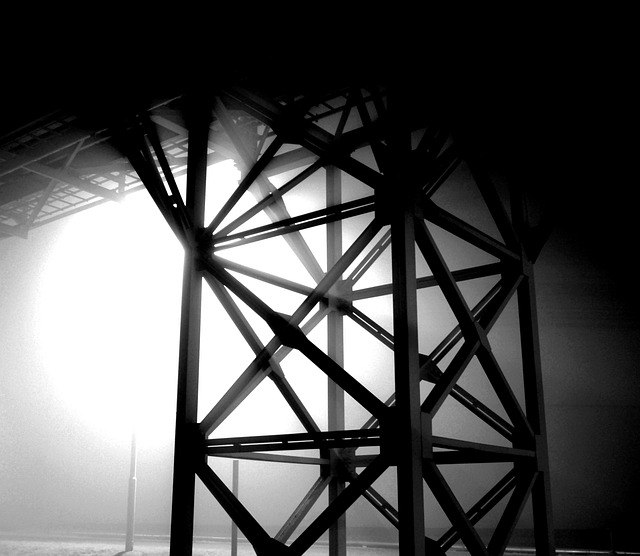Mastering weldment fundamentals and selecting appropriate bolted connection methods, such as through-bolted or lap joint bolt connections, ensures precision in structural steel detailing. Meticulous planning, advanced CAD software, strict tolerances, high-quality materials, certified professionals, and regular inspections guarantee accurate integration and structural integrity throughout the fabrication process.
In the realm of fabrication, achieving precision in structural steel detailing is paramount. This article explores two critical aspects: weldment and bolted connection. We delve into understanding the fundamentals of weldment for structural steel, examining various bolted connection types and their advantages. Furthermore, it highlights the importance of precision in detail for fabrication accuracy, providing best practices for seamless integration and enhanced structural strength. By mastering these techniques, professionals can ensure high-quality, durable structures.
Understanding Weldment Basics for Structural Steel
Understanding the fundamentals of weldment is paramount in ensuring fabrication accuracy, especially when working with structural steel. Welding involves joining metal surfaces through melting and fusing them together, creating a strong bond that can support significant structural loads. In structural steel detailing, various types of welds—such as butt, fillet, and lap joints—are employed based on the specific application’s requirements. Each type has unique characteristics, strength levels, and placement considerations that must be meticulously planned to guarantee structural integrity.
Structural steel detailing for weldments requires precise dimensions, tolerances, and material properties to be incorporated into the design. This includes selecting appropriate welding procedures, understanding heat-affected zones, and accounting for factors like corrosion resistance and fatigue life. Effective communication between engineers, fabricators, and welders is crucial to ensure that the final product meets the required standards and specifications, upholding safety and structural accuracy across all projects.
Bolted Connections: Types and Their Advantages
Bolted connections are a fundamental aspect of structural steel detailing, offering a versatile and secure method for joining components. These connections come in various types, each with unique advantages tailored to specific project needs. One common type is the through-bolted connection, where bolts pass through both workpieces, providing exceptional strength and stability. This design is particularly effective for heavy structures, ensuring precise alignment and preventing displacement under load.
Another popular variant is the lap joint bolt connection, ideal for situations where access to the rear side of the assembly is limited. Here, bolts secure one member against another, creating a robust joint without requiring through-access. Such connections are essential in complex fabrication processes, allowing for efficient assembly and ensuring structural integrity despite space constraints.
Precision in Detail: Ensuring Fabrication Accuracy
Precision in detail is paramount in structural steel fabrication, where even the slightest deviation can have significant implications. Achieving accuracy involves meticulous planning and execution, from designing intricate structural steel detailing to implementing precise welding and bolted connection techniques. Every joint, seam, and fastening point must be carefully considered and executed to ensure structural integrity and performance.
Structural steel detailing requires a deep understanding of engineering principles, material properties, and the specific demands of each project. Professionals in this field employ advanced technologies like computer-aided design (CAD) software to create detailed blueprints and models, minimizing errors and maximizing efficiency. This meticulous approach extends to on-site fabrication, where skilled workers utilize specialized equipment to achieve seamless welds and secure bolted connections, adhering strictly to industry standards and tolerances.
Best Practices for Seamless Integration and Strength
Achieving seamless integration and strength in welded and bolted connections is paramount for fabrication accuracy, especially with structural steel detailing. Best practices include adhering to strict tolerances during design and production stages to ensure components fit together perfectly. This meticulousness minimizes gaps or misalignments that can compromise structural integrity.
Additionally, utilizing high-quality materials and employing expert welders certified in relevant standards guarantees robust connections. Proper bolting techniques, such as using the correct torque values and fastening patterns specified in engineering drawings, further enhance strength. Regular inspections throughout fabrication ensure any deviations from these best practices are promptly addressed, promoting consistent quality across all structural steel detailing stages.
In the realm of structural steel fabrication, achieving precision through meticulous weldment and bolted connection detailing is paramount. By understanding the fundamentals of weldment and exploring various bolt connection types, fabricators can ensure structural integrity and optimize performance. Adhering to best practices for accuracy during every step guarantees seamless integration, enhancing overall strength and quality. This focus on structural steel detailing is crucial for creating robust frameworks that meet modern construction demands.
